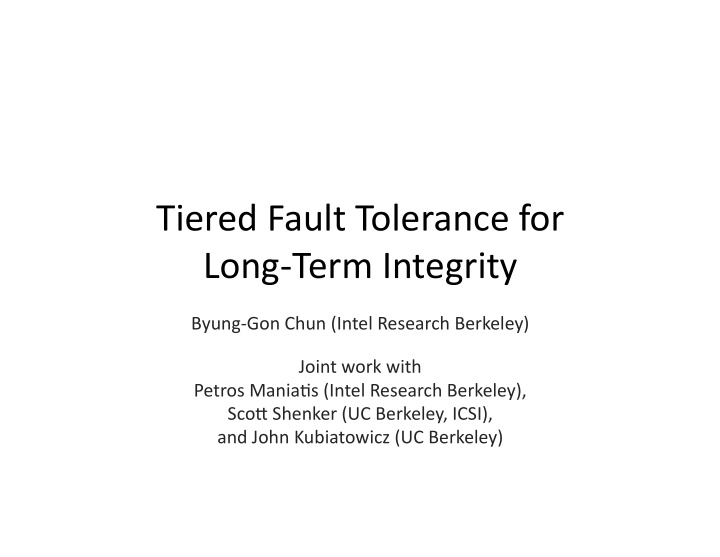



Tiered Fault Tolerance for Long‐Term Integrity Byung‐Gon Chun (Intel Research Berkeley) Joint work with Petros ManiaCs (Intel Research Berkeley), ScoF Shenker (UC Berkeley, ICSI), and John Kubiatowicz (UC Berkeley)
Long‐term applicaCons read(x‐file) write(x‐file, )
Near‐term soluCons do not fit • BFT replicated systems: correct if the number of faulty replicas is always less than some fixed threshold (1/3 of the replicas)
Near‐term soluCons do not fit Node Node Node Node
A new approach to designing long‐term applicaCons • A reliability of a system’s components over long spans of Cme can vary dramaCcally • Consider this differenCaCon for long‐term applicaCons => Tiered fault‐tolerant system framework • Apply the framework to construct Bonafide , a long‐term key‐value store
Roadmap • Tiered fault tolerance framework • Bonafide: a long‐term key‐value store – Tiers: Trusted, Semi‐trusted, Untrusted • EvaluaCon
Monolithic fault‐tolerant system model Node Node Node Node
Tiered fault‐tolerant system model Node Node Node Node
Sources of differenCaCon • Different assurance pracCces – Formally verified components vs. type‐unsafe so\ware • Care in the deployment of a system – Tight physical access controls, responsive system administraCon vs. unreliable organizaCon • Rolling procurement of hardware and so\ware – A trusted logical component vs. a less trusted component • Limited exposure – Mostly offline vs. online
ReallocaCon of dependability budget • Use differenCaCon to refactor systems into mulCple components in different fault Cers • Different operaConal pracCces for each component class Low‐trust High‐trust component component Buggier Formally verified Larger Limited funcConality Run conCnuously Run infrequently/briefly
Roadmap • Tiered fault tolerance framework • Bonafide: a long‐term key‐value store – Tiers: Trusted, Semi‐trusted, Untrusted • EvaluaCon
Bonafide • A key‐value store designed to provide long‐ term integrity using the Cered fault framework – Non‐self‐cerCfying data – A naming service for self‐cerCfying archival storage • Simple interface: – Add( key, value ) – Get( key ) ‐> value
Design RaConale • Refactor the fucConality of the service into – A more reliable fault Cer for state changes – A less reliable fault Cer for read‐only state queries • IsolaCon between these two Cers – Trusted component for protecCng state during execuCon of the unreliable Cer – Use an algorithm to protect large service state with the component • Mask faults of the component in the more reliable Cer – Use a BFT replicated state machine – Mostly offline, execute in a synchronized fashion
OperaCon of Bonafide S: Service U: Update S U S U S U Node 1 Node 2 Node N (N=3f+1) Time
Components in Bonafide and their associated fault Cers Fault bound Component When How used 0 Watchdog Periodic Invoked MAS (Moded S phase Read AFested Storage) U phase WriFen/Read 1/3 Update U phase Replicate store ByzanCne Serve ADDs Unbounded Service S phase Serve GETs Buffer ADDs Audit/Repair
Guarantees • Guarantees integrity of returned data under our Cered fault assumpCon • Ensures liveness of S phases with fewer than 2/3 faulty replicas during S phases • Ensures durability if the system creates copies of data faster than they are lost
Bonafide replica state and process Trusted storage Moded‐AFested Storage (MAS) Get Audit/ Update Repair AuthenCcated Search Tree (AST) Add Buffer U phase S phase Untrusted storage
Top Cer: trusted • Cryptography and trusted hardware • Watchdog: Cme source, periodic reboot, sets a mode bit of MAS • MAS: a mode bit, a set of storage slots, signing key – Store( q, v ): store value v at slot q only in U phases – Lookup( q, z ) ‐> value v of slot q and fresh aFestaCon (nonce z )
BoFom Cer: get Get operaCon (S phase) <Get,k,z> <Get,k,z> Client <Get,k,z> f+1 (=2) Reply,k,v,proof,<rd,z> valid matching <Get,k,z> responses Reply,k,v,proof,<rd,z>
BoFom Cer: add Add operaCon (S phase) <Add,k,v> <Add,k,v> Client <Add,k,v> f+1 (=2) Reply,k,v,proof,<rd,z> valid matching <Add,k,v> responses Reply,k,v,proof,<rd,z> Replies with MAS aFestaCon are sent a\er the following U phase.
BoFom Cer: audit and repair MAS Fetch
Middle Cer: update process Reboot 2f + 1 (=3) PBFT agreements AST update/ Checkpoint Time
EvaluaCng the performance of Bonafide implementaCon • A prototype built with sfslite, PBFT, Berkeley DB libraries – Server Add/Get, Audit/Repair, Update processes – Client proxy process • Experiment setup – Four replica nodes (outdated P4 PCs) running Fedora in a LAN – 1 million key‐value pairs iniCally populated – Add/Get Cme, Audit/repair Cme, U phase duraCon
Performance evaluaCon Get/Add Cme Audit/Repair Cme Opera:on Time (ms) Data loss (%) Audit/Repair Time (s) Mean (std) Mean (std) Get 3.1 (0.24) 0 554.5 (54.6) Add 1.0 (0.21) 1 612.9 (30.3) 10 1147.6 (33.3) 100 3521.5 (201.6) U phase duraCon Ac:on Time (s) Mean (std) Reboot 86.6 (2.1) Proposal creaCon 8.0 (4.0) Agreement 5.2 (1.0) AST update/Checkpoint 271.1 (24.8) Total 370.9 (24.0)
Availability 1 0.99 Availability 0.98 0.97 U phase period = 9 hours 0.96 U phase period = 6 hours U phase period = 3 hours 0.95 1 2 3 4 5 6 7 8 9 U phase dura:on (minutes)
Related work • BFT systems – PBFT, PBFT‐PR, COCA – BFT‐2F, A2M‐PBFT, A2M – BFT erasure‐coded storage • DifferenCaCng trust levels – Hybrid system model – wormholes model – Hybrid fault model – Different fault thresholds to different sites or clusters • Long‐term stores – Self‐cerCfying bitstore – AnCquity, Oceanstore, Pergamum, Glacier, etc. – LOCKSS, POTSHARDS, CATS
Conclusion • Present a Cered fault‐tolerant system framework ‐ A2M (SOSP07), Bonafide (FAST09), TrInc (NSDI09) • Build Bonafide, a safer key‐value store (of non‐ self‐cerCfying data) for long‐term integrity with the framework
Thank you!
Recommend
More recommend